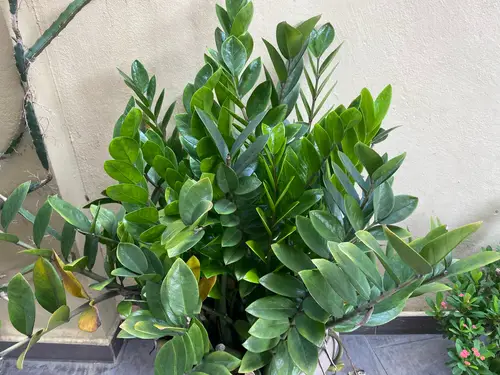ZZ plants are a popular choice for indoor plants due to their low maintenance and hardiness. However, even the most resilient plant can experience issues, such as drooping leaves. ZZ plant owners may become concerned when they notice their ZZ plant is drooping, but fortunately, there are solutions to this problem.
Understanding ZZ plants is important to determine the cause of drooping leaves. ZZ plants are native to Africa and are known for their thick, waxy leaves and bulbous roots. They are capable of surviving in low light conditions and can go without water for long periods.
ZZ plants are often grown for their air-purifying qualities and are safe for pets and humans.
Key Takeaways
- ZZ plants are hardy and low maintenance, but can experience drooping leaves.
- Understanding ZZ plants is important to determine the cause of drooping leaves.
- Common causes of drooping ZZ plants include overwatering, poor lighting, and imbalanced fertilizer.
Check out these other popular posts:
Understanding ZZ Plants
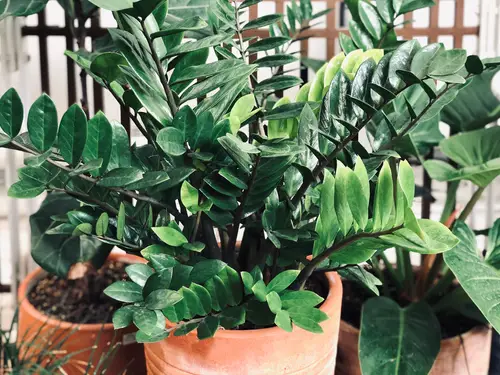
ZZ plants, also known as Zamioculcas zamiifolia or the Zanzibar gem, are a popular houseplant due to their ease of care and unique appearance. They are native to Eastern Africa and belong to the Araceae family. ZZ plants are known for their glossy, dark green leaves that can grow up to 3 feet long.
One of the reasons ZZ plants are so popular is because they thrive in low light conditions, making them a great choice for indoor spaces with limited natural light. They can also tolerate a wide range of temperatures and do not require frequent watering, making them a low-maintenance option for busy plant owners.
ZZ plants are also known for their air-purifying properties. According to a study by NASA, ZZ plants can remove toxins such as benzene, toluene, and xylene from the air, making them a great addition to any home or office space.
Despite their hardy nature, ZZ plants can still experience issues such as drooping leaves or stems. This can be caused by a variety of factors, including overwatering, underwatering, lack of light, incorrect fertilizing, and poor overall growing conditions.
To ensure a healthy ZZ plant, it is important to provide it with the right growing conditions, including well-draining soil, indirect light, and moderate watering. ZZ plants can also benefit from occasional fertilizing with a balanced houseplant fertilizer.
Symptoms of a Drooping ZZ Plant
ZZ plants are known for their resilience and ability to thrive in low light and dry conditions. However, even the hardiest of plants can struggle if they are not given the proper care. One of the most common issues ZZ plant owners face is drooping. Here are some symptoms to look out for:
1. Drooping Leaves
The most obvious symptom of a drooping ZZ plant is, of course, drooping leaves. The leaves may appear limp and lifeless, and may even be touching the ground. This is often a sign that the plant is not getting enough water or that it is being overwatered.
2. Yellow Spots on Leaves
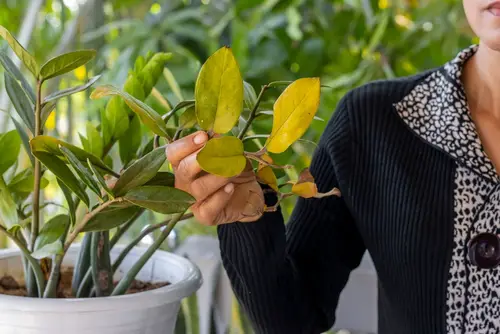
Another symptom of a drooping ZZ plant is yellow spots on the leaves. This can be a sign of overwatering, as the roots may be sitting in water and the plant is unable to absorb nutrients properly. It can also be a sign of underwatering, as the leaves may be drying out and turning yellow.
3. Shriveled or Mushy Stems
If the stems of your ZZ plant are shriveled or mushy, this is a sign that the plant is not getting enough water. Shriveled stems indicate that the plant is dehydrated, while mushy stems indicate that the plant has been overwatered and the roots are starting to rot.
4. Leggy Growth
Leggy growth is another symptom of a drooping ZZ plant. This occurs when the plant is not getting enough light, causing the stems to grow long and spindly in an attempt to reach the light source.
5. Yellow Leaves
Yellow leaves are a common symptom of a drooping ZZ plant. This can be a sign of overwatering or underwatering, as well as a lack of nutrients. If the leaves are yellowing and falling off, it may be a sign that the plant is not getting enough light.
ZZ Plant Is Drooping – 7 Common Problems
ZZ plants are known for their low maintenance, easy care, and ability to thrive in low light conditions. However, despite their resilience, ZZ plants can sometimes experience drooping, which is a sign that something is wrong. Here are some of the most common causes of drooping in ZZ plants:
1. Overwatering
Overwatering is one of the most common reasons why ZZ plants droop. When the soil is constantly wet, it can lead to root rot, which can cause the plant to wilt and droop. ZZ plants prefer to dry out between watering, so it is essential to let the soil dry out before watering again.
2. Underwatering
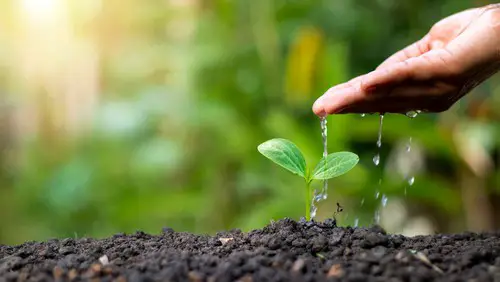
Underwatering can also cause ZZ plants to droop. When the soil is too dry, the plant can become dehydrated, causing the leaves to wilt and droop. ZZ plants should be watered thoroughly when the top inch of soil is dry to the touch.
3. Watering Issues
In addition to overwatering and underwatering, watering issues such as irregular watering or using the wrong type of water can also cause ZZ plants to droop. ZZ plants prefer to be watered with room temperature water that is free of chlorine and other chemicals.
4. Incorrect Lighting
ZZ plants prefer bright, indirect light but can tolerate low light conditions. However, if the plant is exposed to too much direct sunlight or placed in a dark corner, it can cause the leaves to droop.
5. Cold Drafts
Cold drafts can also cause ZZ plants to droop. ZZ plants prefer warm temperatures and can be sensitive to cold air. If the plant is placed near a drafty window or air conditioning vent, it can cause the leaves to wilt.
6. Stress
Stress can also cause ZZ plants to droop. Stress can be caused by a variety of factors such as changes in temperature, humidity, or lighting conditions. ZZ plants can also experience stress due to pests, diseases, or physical damage.
7. Transplant Shock
Transplant shock can occur when a ZZ plant is moved to a new pot or location. The plant may experience drooping as it adjusts to its new environment. It is essential to give the plant time to acclimate and avoid overwatering during this period.
Watering Needs and Issues

ZZ plants have specific watering needs that must be met to keep them healthy and thriving. Overwatering is one of the most common causes of drooping ZZ plants. ZZ plants are sensitive to excess water and can easily succumb to root rot if overwatered.
To avoid overwatering, ZZ plants should be watered only when the top inch of soil is dry to the touch. The frequency of watering will depend on various factors, including the plant’s size, the pot’s size, and the environment’s humidity level.
ZZ plants are drought-tolerant and can survive for extended periods without water. However, prolonged drought can cause the leaves to wilt and droop.
Underwatering can also cause ZZ plants to droop. ZZ plants should never be allowed to completely dry out, as this can lead to dehydration and leaf drop. ZZ plants should be watered deeply, allowing the water to soak into the soil.
It is essential to establish a consistent watering schedule for ZZ plants. ZZ plants prefer to be watered deeply but infrequently, rather than receiving small amounts of water frequently. A moisture meter can be used to determine when the plant needs watering.
If ZZ plants are showing signs of drooping, it is essential to check the soil’s moisture level. If the soil is too wet, it may be necessary to adjust the watering schedule or repot the plant into a container with better drainage.
If the soil is too dry, the plant should be watered deeply and placed in a location with higher humidity levels to prevent further dehydration.
Light and Temperature Requirements
ZZ plants require bright, indirect light to thrive. Direct sunlight can burn the leaves, causing them to turn yellow or brown. If the plant is not receiving enough light, it may become weak and droopy. In such cases, the ZZ plant should be moved to a brighter location.
If the ZZ plant is placed in low light conditions, it will grow slowly and may become leggy. Leggy plants have long, thin stems with few leaves. To avoid this, ZZ plants should be placed in an area with bright, indirect light. If there is not enough natural light available, artificial light can be used to supplement the plant’s needs.
Temperature is also an important factor in the growth of ZZ plants. They prefer warm temperatures between 65-75°F (18-24°C). If the temperature drops below 60°F (15°C), the plant may become dormant and stop growing. In such cases, the ZZ plant should be moved to a warmer location.
During the winter months, ZZ plants may require additional warmth. If the temperature drops below 60°F (15°C), a heating pad can be placed under the plant’s pot to keep it warm.
Soil and Drainage Considerations

One of the most common reasons why ZZ plants droop is due to poor soil and drainage. ZZ plants prefer well-draining soil that is not too dense or compact. When the soil is too dense, it can cause water to accumulate and lead to root rot, which can cause the plant to droop.
When planting ZZ plants, it is essential to ensure that the pot has adequate drainage holes. Without proper drainage, water can accumulate at the bottom of the pot and cause the soil to become waterlogged, leading to root rot and other issues.
To ensure proper drainage, it is recommended to use a soil mix that is specifically designed for succulents and cacti. This type of soil mix typically contains a combination of perlite, sand, and other materials that help to improve drainage and prevent water from accumulating in the soil.
In addition to using a well-draining soil mix, it is also important to avoid overwatering ZZ plants. ZZ plants are native to Eastern Africa and can survive in dry conditions. Overwatering can cause the soil to become waterlogged, leading to poor drainage and root rot.
To prevent overwatering, it is recommended to wait until the soil is completely dry before watering ZZ plants. It is also important to avoid watering the plant too frequently, as this can also lead to poor drainage and other issues.
Nutrition and Fertilization
ZZ plants require minimal fertilization, but they do need a balanced diet to thrive. Over-fertilizing can lead to root burn and cause the plant to droop. On the other hand, a lack of fertilizer can result in stunted growth and yellowing leaves. Therefore, it is important to ensure that the plant receives the right amount of nutrients and fertilizers.
One way to fertilize ZZ plants is by using a liquid fertilizer. Liquid fertilizers are easy to use and are quickly absorbed by the plant. It is recommended to use a balanced liquid fertilizer with a 10-10-10 NPK ratio.
This ratio ensures that the plant receives equal amounts of nitrogen, phosphorus, and potassium. ZZ plants can be fed with liquid fertilizer once a month during the growing season, which is from spring to fall.
Another way to fertilize ZZ plants is by using slow-release fertilizers. Slow-release fertilizers are ideal for those who do not want to fertilize their plants frequently. These fertilizers release nutrients slowly over a period of time, providing a steady supply of nutrients to the plant.
It is recommended to use a slow-release fertilizer with a 14-14-14 NPK ratio. This ratio ensures that the plant receives equal amounts of nitrogen, phosphorus, and potassium. ZZ plants can be fed with slow-release fertilizer once every three months during the growing season.
It is important to note that ZZ plants do not require fertilization during the dormant season, which is from late fall to early spring. During this time, the plant is not actively growing, and fertilization can do more harm than good.
Repotting and Root Issues
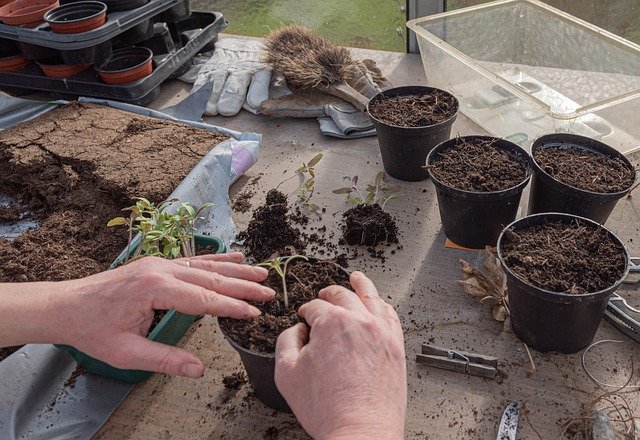
If a ZZ plant is drooping, it could be a sign of root issues. ZZ plants have rhizomes, which are thick underground stems that can store water. However, when they receive excessive water, the rhizomes can become waterlogged, leading to root rot.
Root rot is a fungal disease that can cause the roots to decay, leading to drooping leaves and stems.
One way to prevent root rot is by repotting the ZZ plant. Repotting a ZZ plant can help to refresh the soil, remove any dead roots, and provide more space for the roots to grow. ZZ plants prefer well-draining soil, so it’s essential to choose a pot with good drainage holes and use a well-draining potting mix.
When repotting a ZZ plant, it’s important to be gentle with the roots. ZZ plants have delicate roots that can easily break when disturbed. Carefully remove the plant from its current pot and gently loosen the roots. Remove any dead or rotten roots and trim any long roots.
If the ZZ plant is root-bound, it means that the roots have outgrown the pot and are tightly packed together. Root-bound plants can cause the soil to become compacted, leading to poor drainage and water retention.
To check if a plant is root-bound, gently remove it from its pot and inspect the roots. If the roots are tightly packed and have formed a circle around the soil, it’s time to repot the plant.
Care and Maintenance
ZZ plants are known for their minimal care requirements, making them an excellent choice for those who want to add some greenery to their indoor space without having to devote a lot of time and effort to plant care.
However, ZZ plants can still experience issues like drooping if they are not given the proper care and maintenance. Here are some tips for keeping your ZZ plant healthy and happy:
1. Light
ZZ plants prefer bright, indirect light, but they can also tolerate low light conditions. If your ZZ plant is drooping, it may be because it is not getting enough light.
Consider moving it to a brighter location, such as near a window that receives bright, indirect light. Be careful not to expose your ZZ plant to direct sunlight, as this can scorch the leaves.
2. Water
Overwatering is one of the most common causes of ZZ plant drooping. ZZ plants are drought-tolerant and prefer to be on the dry side, so it’s essential to let the soil dry out between waterings.
When you do water your ZZ plant, make sure to water it thoroughly, allowing the excess water to drain out of the bottom of the pot. Empty any standing water from the saucer or decorative pot after watering to prevent the roots from sitting in water.
3. Fertilizer

ZZ plants do not require frequent fertilization, but they can benefit from a light feeding every few months during the growing season. Use a balanced, water-soluble fertilizer, and follow the instructions on the packaging carefully. Overfertilizing can lead to salt buildup in the soil, which can cause root damage and drooping.
4. Temperature and Humidity
ZZ plants prefer temperatures between 60-75°F (15-24°C) and can tolerate a range of humidity levels. However, they may be more prone to drooping in cold temperatures or low humidity conditions.
Keep your ZZ plant away from cold drafts, and consider using a humidifier or placing a tray of water near the plant to increase the humidity in the air.
5. Repotting
ZZ plants do not require frequent repotting and can thrive in a slightly crowded pot. However, if your ZZ plant is severely root-bound, it may benefit from repotting into a slightly larger pot with fresh potting soil. Repotting can also help improve drainage and prevent overwatering.
By following these care and maintenance tips, you can keep your ZZ plant healthy and prevent drooping. Remember, ZZ plants are low-maintenance, but they still require some attention to thrive.
ZZ Plant and Pets/Humans
ZZ plants are known for their hardiness and low maintenance, making them a popular choice for indoor plant enthusiasts. However, it’s essential to be aware of the potential risks associated with ZZ plants for pets and humans.
ZZ Plant and Pets
ZZ plants are mildly toxic to pets, including cats and dogs. The plant contains calcium oxalate crystals, which are toxic to animals when ingested. Symptoms of ZZ plant toxicity in pets include vomiting, diarrhea, and difficulty swallowing.
If a pet has ingested ZZ plant leaves or stems, it’s essential to seek veterinary care immediately. Pet owners should keep ZZ plants out of reach of their pets and consider choosing pet-friendly plants instead.
ZZ Plant and Humans
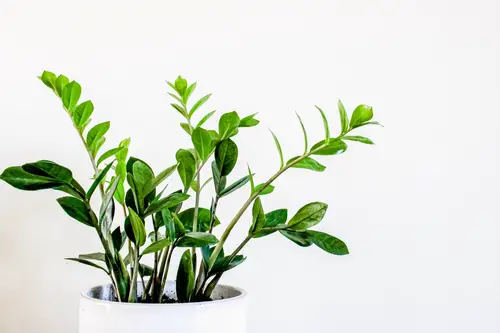
Like pets, ZZ plants are also mildly toxic to humans when ingested. The calcium oxalate crystals present in the plant can cause skin irritation, itching, and redness.
It’s essential to handle ZZ plants with care and wear gloves when pruning or repotting the plant. If ZZ plant sap comes in contact with the skin, it’s crucial to wash the affected area with soap and water immediately.
Other Factors
Aside from the common reasons for ZZ plant drooping, there are other factors that can affect the health and growth of the plant. Here are some of them:
1. Humidity
ZZ plants thrive in humid environments, and low humidity levels can cause the leaves to dry out and droop. This is especially true during the winter months when indoor heating can make the air dry. To increase humidity levels, consider using a humidifier or placing a tray of water near the plant.
2. Stunted Growth
If a ZZ plant is not growing as expected, it may be due to a lack of nutrients or inadequate lighting. ZZ plants require bright, indirect light to grow properly, and insufficient light can lead to stunted growth.
Additionally, ZZ plants should be fertilized every two to three months during the growing season to ensure they have enough nutrients to thrive.
3. Summer Months
During the summer months, ZZ plants may need more frequent watering as the warmer temperatures can cause the soil to dry out more quickly. However, it’s important not to overwater the plant, as this can lead to root rot and other issues.
4. Stems
If the stems of a ZZ plant are drooping, it may be due to physical damage or stress. ZZ plants can be sensitive to changes in their environment, so it’s important to avoid moving them around too much or exposing them to extreme temperatures.
5. Household Humidity

In addition to low humidity levels, high levels of household humidity can also cause issues for ZZ plants. Excessive moisture in the air can lead to fungal growth and other problems, so it’s important to maintain a healthy balance of humidity in the home.
Frequently Asked Questions
How do I revive a drooping ZZ plant?
Reviving a drooping ZZ plant involves identifying the cause of the drooping and taking appropriate action. If the cause is overwatering, stop watering the plant and allow the soil to dry out before watering again.
If the cause is underwatering, water the plant thoroughly and ensure it receives regular watering. If the cause is lack of light, move the plant to a brighter location. If the cause is pests or disease, treat the plant with appropriate measures.
What causes ZZ plants to droop?
The most common causes of ZZ plant drooping are overwatering, underwatering, lack of light, and pests or disease. ZZ plants are hardy and can tolerate low light and infrequent watering, but they can still suffer from drooping if not given the right conditions.
How often should I water a ZZ plant to prevent drooping?
ZZ plants prefer to dry out between waterings, so it is best to water them when the top inch of soil is dry to the touch. The frequency of watering will depend on the environment and growing conditions, but it is generally recommended to water ZZ plants every 2-3 weeks.
Can overwatering cause ZZ plants to droop?
Yes, overwatering is a common cause of ZZ plant drooping. ZZ plants are susceptible to root rot if they are kept in soil that is too wet, which can lead to drooping and other issues.
What is the best way to support ZZ plant stems?
If your ZZ plant is drooping due to weak or unsupported stems, you can support them with stakes or bamboo sticks. Gently tie the stems to the stakes with soft plant ties or twine, being careful not to damage the stems.
How can I encourage my ZZ plant to grow bushier?
To encourage your ZZ plant to grow bushier, you can prune the stems and propagate the cuttings. Pruning will stimulate new growth and branching, while propagating the cuttings will give you new ZZ plants to add to your collection.

Hey, I’m Lisa and I’ve been an avid gardener for over 30 years. I love writing, talking and living in the garden! Feel free to connect with me on my socials below

